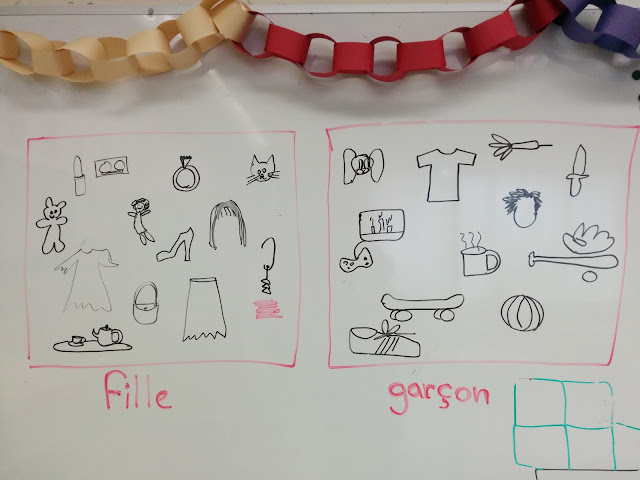We began playing a new game for Daily 5 word work, in addition to making words with letter tiles. It is a word sorting game, where 2 kids take turns pulling a word from an envelope. They need to both read the word and make the gestures for the sounds in the word. Then the person who picked the word puts it in a category, according to the vowel or "son" in the word. Their partner then picks a word, they both say it and make gestures, and the partner categorizes the word. The fun kicks in when someone gets a word with a vowel or "son" that their partner has already found a word for, because the player gets to steal their partner's word(s) in that category.
We also made thank-you cards for the caretakers and for a teacher who gave some costumes to our class. It's so important to remember to appreciate all that people do for us!
We tackled a story problem to do with measurement, in pairs, with the goal of increasing the collaboration level of the partners. I told the kids that both people had to understand the problem before they began to put anything on their page (more confident kids tend to blaze ahead and leave their partners in the dust). This resulted in more conversation about the problem, with room still for improvement. The kids can be very focused on getting the "right" answer, without taking the time to engage deeply with a math problem. We will keep working on these skills.
In measurement, we moved on to talk about area. In order to understand what area is, we worked with the tangram sets that are already very familiar. The tangram set has 2 large triangles, 1 medium triangle, 2 small triangles, a square and a parallelogram.
We looked at some of the relationships among the tangram pieces. For example, the 2 small triangles cover the square exactly. They also cover the parallelogram. There are lots of combinations of shapes that cover another shape, and this means that they have the same area. I showed the kids how this could be expressed as a "math sentence" using plus signs and equal signs. I also showed how we could make "greater than/less than" math sentences with shapes that are bigger or smaller in comparison.
Then the kids set to making their own math sentences with tangram pieces.
Then the kids did a lot of hands on measuring of classroom objects again, but this time using units such as playing cards to cover a surface. They measured a desk, a book, and a chair with playing cards, always estimating first before measuring. They also estimated and measured the area of shapes on a worksheet using interlocking cubes.
We returned to our questions about energy. Each student chose which question they would like to focus on. Then in small groups they drew and wrote about their question. On another day I asked them to come up with an answer to their question, just their best guess, and we called these their "theories". The kids wrote their theories up on another piece of paper. I asked them to each keep their question in mind and try to find some answers when we were at the Kortright Center.
Our field trip day was really fun and interesting for the kids. We learned about renewable and non-renewable energy sources - the Kortright Center is fully powered by wind and solar energy! We learned about solar panels and wind turbines, the need to store energy for cloudy days, and how most energy sources ultimately originate from the sun's energy. And we had a blast playing outside after lunch and exploring the wooded trails. The kids played tag on hay bales and rolled down hills until they were too dizzy to stand up!
At the end of the week, students were treated to "A (mini) History of Theatre for Kids", a performance from Little Goat Theatre Company.





























































